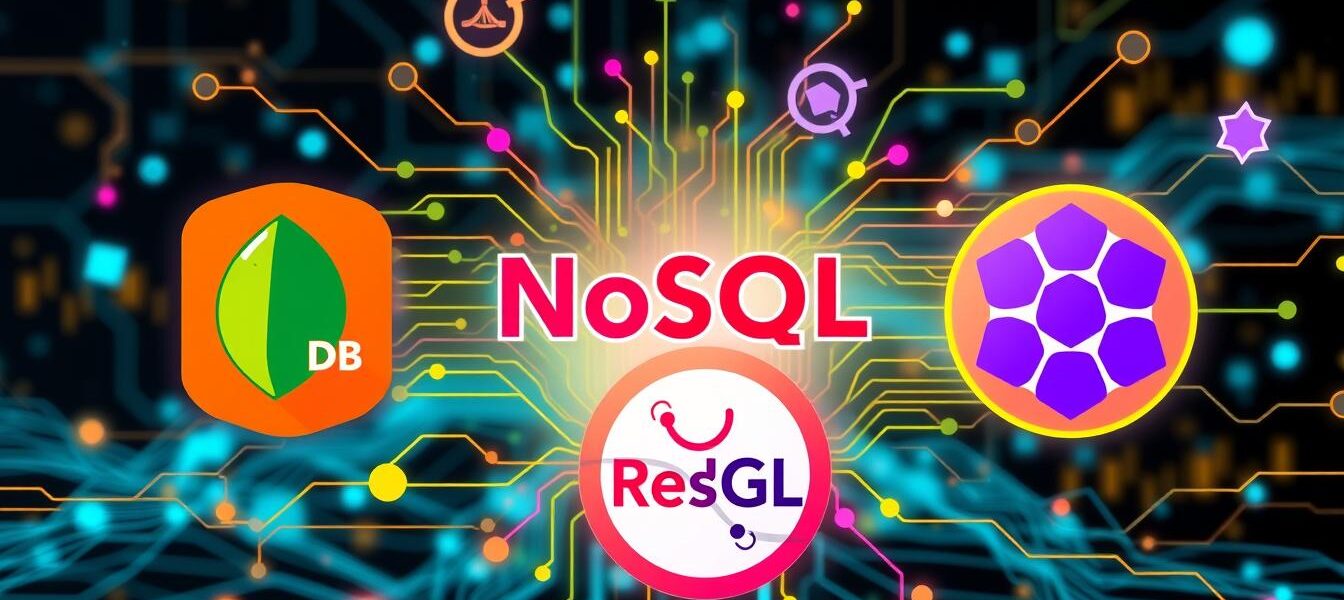Understanding NoSQL, In the ever-evolving world of data management, the traditional relational database model has faced increasing challenges in keeping up with the demands of modern applications. Enter NoSQL – a non-relational approach to data storage and retrieval that is rapidly gaining popularity. Understanding NoSQL and its potential benefits can help you determine when and why it might be the optimal choice for your data management needs.
NoSQL databases, short for “Not only SQL,” offer a refreshing alternative to the rigid structure of their relational counterparts. These non-relational databases prioritize flexibility, scalability, and performance, making them well-suited for handling the diverse and ever-changing data requirements of today’s digital landscape. By exploring the fundamentals of NoSQL and its key differences from relational databases, you’ll gain valuable insights into when and why you should consider adopting a non-relational database solution.
Key Takeaways Understanding NoSQL
- NoSQL databases offer a flexible, non-relational approach to data management, designed to meet the demands of modern applications.
- They differ from traditional relational databases in their data models, schema, and scalability capabilities.
- NoSQL databases are particularly well-suited for handling large volumes of unstructured data, real-time analytics, and scenarios where scalability and high availability are crucial.
- Exploring the various types of NoSQL databases, such as key-value, document-oriented, column-family, and graph databases, can help you determine the right solution for your specific needs.
- Understanding the key benefits of NoSQL, including scalability, performance, and flexible data models, can guide you in making informed decisions about when to choose a non-relational database over a traditional relational one.
What is NoSQL? Understanding NoSQL
NoSQL, short for “Not only SQL,” is a broad category of database management systems that offer an alternative to traditional relational databases. Unlike the rigid structure of relational databases, NoSQL databases provide a more flexible and scalable approach to data storage and retrieval. These non-relational databases are designed to handle large volumes of unstructured or semi-structured data, making them a popular choice for modern applications that require speed, agility, and high availability.
Explaining the Fundamentals Understanding NoSQL
At the core of NoSQL is the concept of a “document-oriented” data model, where information is stored in flexible, schema-less documents rather than in traditional tables with predefined schemas. This approach allows for the storage and retrieval of data in a more natural and intuitive way, often better suited to the needs of modern applications and big data initiatives.
Differences from Relational Databases Understanding NoSQL
The key differences between NoSQL and relational databases lie in their data models, scalability, and flexibility. While relational databases enforce a rigid structure and require precise definitions of data relationships, NoSQL databases embrace a more fluid and adaptable approach. This enables them to handle large-scale, unstructured data more efficiently, making them a popular choice for applications that require rapid data processing and flexible schema designs.
To illustrate the contrast, consider the following table that highlights some of the fundamental differences between NoSQL fundamentals and Relational databases vs NoSQL:
| Feature | Relational Databases | NoSQL Databases |
|---|---|---|
| Data Model | Tabular, with predefined schemas | Document-oriented, schema-less |
| Scalability | Vertically (by upgrading hardware) | Horizontally (by adding more servers) |
| Flexibility | Limited, due to rigid schema structure | High, with the ability to easily adapt to changing data requirements |
| Query Language | SQL (Structured Query Language) | Varied, depending on the specific NoSQL database |
By understanding these fundamental differences between NoSQL fundamentals and Relational databases vs NoSQL, organizations can make informed decisions about which database approach best suits their specific needs and requirements.
Types of NoSQL Databases Understanding NoSQL
As the world of data storage and processing evolves, the demand for more flexible and scalable solutions has given rise to various types of NoSQL database categories. These NoSQL database types cater to diverse data management needs, each offering unique features and capabilities. Let’s explore the main categories of NoSQL databases:
Key-Value Stores Understanding NoSQL
Key-value stores are the simplest form of NoSQL databases, where data is stored as a collection of key-value pairs. This model is highly efficient for use cases that prioritize fast data retrieval and storage, such as caching, session management, and real-time user preferences. Understanding NoSQL
Document Databases
Document databases are designed to handle semi-structured data, storing information in a format similar to JSON or XML. These NoSQL database types excel at managing unstructured data, making them well-suited for content management systems, product catalogs, and web applications. Understanding NoSQL
Column-Family Stores
Column-family stores, also known as wide-column stores, organize data into tables, rows, and dynamic columns. This structure allows for efficient storage and retrieval of large datasets, making them ideal for applications that require high-speed data processing, such as time-series data, sensor data, and user activity logs. Understanding NoSQL
Graph Databases
Graph databases focus on the relationships between data, representing them as nodes and edges. This model is particularly useful for applications that require the exploration of complex connections, such as social networks, recommendation engines, and fraud detection systems. Understanding NoSQL
Each NoSQL database category has its own strengths and use cases, making it essential to understand the specific requirements of your project before selecting the appropriate NoSQL database type. By leveraging the unique features of these diverse solutions, businesses can unlock new possibilities in data management and drive innovation in their respective industries.
Understanding NoSQL
In the dynamic world of data management, Understanding NoSQL has become a critical skill for developers and data professionals. NoSQL concepts encompass a fundamentally different approach to data storage and retrieval, offering a versatile solution to the challenges posed by traditional relational databases.
At the core of NoSQL lies the concept of eventual consistency, which departs from the strict ACID (Atomicity, Consistency, Isolation, Durability) principles of traditional databases. NoSQL systems often adopt the BASE (Basically Available, Soft state, Eventual consistency) model, prioritizing availability and partition tolerance over the rigid consistency requirements of ACID.
This shift in focus allows NoSQL databases to excel in scenarios where scalability, flexibility, and real-time data processing are paramount. By embracing horizontal scaling, NoSQL architectures can effortlessly handle the exponential growth of data, catering to the needs of modern applications and Big Data analytics.
“The future of data management lies in the seamless integration of NoSQL and traditional relational databases, harnessing the strengths of both to tackle the diverse challenges of the digital age.”
As the landscape of data management continues to evolve, a deep understanding of NoSQL principles and their practical applications will be a valuable asset for professionals seeking to stay ahead of the curve.
Key Benefits of NoSQL Databases
As the world becomes increasingly data-driven, businesses are seeking more flexible and scalable database solutions to meet their evolving needs. NoSQL databases have emerged as a powerful alternative to traditional relational databases, offering a range of benefits that can significantly enhance an organization’s data management capabilities.
Scalability and Performance
One of the primary advantages of NoSQL databases is their superior scalability and performance. Unlike relational databases, which can struggle to handle large volumes of data or complex queries, NoSQL systems are designed to scale horizontally, seamlessly accommodating growing data demands and high-traffic workloads. This makes them an ideal choice for applications that require real-time processing, such as social media platforms, e-commerce websites, and IoT (Internet of Things) devices.
Flexible Data Models
Another key benefit of NoSQL databases is their flexible data models. Unlike the rigid, schema-based structure of relational databases, NoSQL systems offer a more dynamic and adaptable approach, allowing for the storage and manipulation of various data types, including structured, semi-structured, and unstructured data. This flexibility enables organizations to quickly adapt to changing business requirements and accommodate new data sources without the need for complex schema migrations or database restructuring.
| Benefit | Description |
|---|---|
| Scalability and Performance | NoSQL databases are designed to scale horizontally, easily handling large volumes of data and high-traffic workloads, making them ideal for real-time processing applications. |
| Flexible Data Models | NoSQL systems offer a more dynamic and adaptable approach to data storage, allowing for the handling of various data types, including structured, semi-structured, and unstructured data. |
By leveraging the benefits of NoSQL databases, organizations can unlock new opportunities for innovation, efficiency, and competitive advantage in today’s rapidly evolving digital landscape.
When to Use NoSQL Databases
In the world of data management, NoSQL databases have carved out a unique niche, particularly when it comes to handling big data and powering real-time analytics. These non-relational databases excel in scenarios where traditional relational databases fall short, making them an invaluable asset for organizations seeking to unlock the full potential of their data.
Big Data and NoSQL
NoSQL databases are designed to tackle the challenges posed by big data – the exponential growth of structured, semi-structured, and unstructured data that traditional databases often struggle to manage effectively. These non-relational systems excel at storing and processing large volumes of diverse data, from social media posts and sensor readings to customer interaction logs and IoT device data. By eschewing the rigid schemas of relational databases, NoSQL solutions can adapt to the ever-changing nature of big data, providing scalable and efficient storage and retrieval.
Real-Time Analytics and NoSQL
In the age of instant gratification, businesses and organizations demand real-time insights to drive their decision-making. NoSQL databases are well-suited for powering real-time analytics applications, offering low latency and high availability to meet the needs of modern, data-driven enterprises. These non-relational systems can handle the rapid ingestion and processing of large data streams, enabling organizations to make timely, informed decisions in fast-paced environments.
Whether you’re managing vast troves of unstructured data or require lightning-fast access to mission-critical insights, NoSQL databases have emerged as a powerful solution to tackle these challenges. By understanding the unique capabilities of these non-relational systems, you can unlock new opportunities for your organization to thrive in the ever-evolving world of data management.
Popular NoSQL Database Solutions
As the demand for managing and analyzing large, diverse datasets continues to grow, the popularity of NoSQL database solutions has soared. These innovative platforms offer a flexible, scalable alternative to traditional relational databases, catering to the needs of modern applications and big data initiatives. Let’s explore some of the most widely-used Popular NoSQL databases and their key features.
MongoDB: The Document-Oriented Powerhouse
MongoDB, a leading NoSQL database solution, is renowned for its document-oriented data model. By storing data in flexible, JSON-like documents, MongoDB provides developers with the freedom to adapt their data structures as requirements evolve. This flexibility, combined with its scalability and high-performance features, makes MongoDB a popular choice for web applications, mobile apps, and content management systems.
Cassandra: Distributed and Scalable
Cassandra, another prominent NoSQL database, excels in its distributed, column-family data model. Designed for high availability and fault tolerance, Cassandra is well-suited for applications that require low latency and massive scalability, such as real-time analytics, IoT, and social media platforms.
Couchbase: The Versatile Document-Oriented Database
Couchbase is a versatile NoSQL database solution that combines the flexibility of a document-oriented database with the performance and scalability of an in-memory cache. Its hybrid approach allows developers to handle a wide range of use cases, from mobile and web applications to e-commerce and enterprise-level systems.
Redis: The In-Memory Data Structure Store
Redis, a popular NoSQL database, is an in-memory data structure store known for its lightning-fast performance. It excels in use cases that require low-latency, real-time data processing, such as caching, messaging queues, and session management.
These are just a few examples of the Popular NoSQL databases that have emerged as powerful solutions for managing and analyzing large, diverse datasets. As businesses and developers continue to seek more flexible, scalable, and high-performing data management options, the adoption of these NoSQL database solutions is expected to grow even further.
Challenges and Limitations
While the benefits of NoSQL databases are significant, it’s important to also understand the potential challenges and limitations associated with these non-relational data storage systems. As organizations consider adopting NoSQL solutions, they should be aware of these NoSQL challenges and NoSQL limitations to make informed decisions.
One of the primary NoSQL challenges is the trade-off between consistency and availability, as defined by the CAP theorem. NoSQL databases often prioritize availability and partition tolerance over strict consistency, which can lead to potential data integrity issues in certain scenarios. This can be particularly problematic for applications that require strong data consistency, such as financial transactions or healthcare records.
Another NoSQL limitation is the need for specialized skills and expertise. Implementing and managing a NoSQL database infrastructure can be more complex compared to traditional relational databases, requiring developers and administrators to have specific knowledge and experience. This can make the adoption and maintenance of NoSQL solutions more challenging, especially for organizations with limited technical resources.
Additionally, the distributed nature of many NoSQL databases can add complexity to the management and monitoring of the overall system. Ensuring the proper coordination, replication, and failover mechanisms can be more challenging compared to a centralized relational database architecture.
“The flexibility of NoSQL comes at the cost of some tradeoffs, such as the need for specialized skills and the potential challenges in ensuring data consistency and integrity.”
Despite these challenges, NoSQL databases continue to be an attractive option for organizations that require scalability, flexibility, and performance in their data management needs. By understanding the potential limitations and carefully evaluating their specific requirements, organizations can make informed decisions about the best data storage solutions to meet their business needs.
Integrating NoSQL with Existing Systems
As the demand for more flexible and scalable data management solutions grows, businesses often find themselves in a position where they need to integrate NoSQL databases with their existing relational database systems and legacy applications. This integration process can be a delicate balance, but with the right strategies, it can be executed seamlessly.
One effective approach is to utilize NoSQL databases as a complement to SQL-based systems, creating a polyglot persistence architecture. This approach allows organizations to leverage the strengths of both database paradigms, using NoSQL for specific use cases that benefit from its flexibility and scalability, while maintaining the reliability and consistency of their established relational databases.
Another strategy is to ensure data synchronization between the NoSQL and SQL systems, enabling a smooth flow of information between the two. This can be achieved through various techniques, such as change data capture, event-driven architectures, or even manually orchestrated data pipelines.
Key Considerations for Integrating NoSQL
- Carefully evaluate the specific use cases and data requirements that would benefit most from a NoSQL approach.
- Develop a robust data integration and synchronization plan to maintain data consistency and integrity across the entire system.
- Invest in training and upskilling your team to ensure they have the necessary expertise to manage and maintain the combined NoSQL and SQL infrastructure.
- Continuously monitor and optimize the performance and scalability of the integrated system to ensure it meets your evolving business needs.
By adopting a strategic and thoughtful approach to integrating NoSQL with existing systems, organizations can unlock the full potential of non-relational databases while preserving the value of their established relational infrastructure.
Conclusion
As we’ve explored throughout this article, NoSQL databases offer a powerful and flexible alternative to traditional relational databases, particularly in the realm of big data, real-time analytics, and applications that demand scalability and high-performance. By understanding the fundamental differences between NoSQL and SQL, as well as the various types of NoSQL solutions available, organizations can make informed decisions about when and why to incorporate these non-relational databases into their technology stack.
The key benefits of NoSQL, such as their ability to handle unstructured data, scale seamlessly, and provide lightning-fast query times, make them an increasingly attractive choice for businesses navigating the challenges of the modern data landscape. Whether your needs lie in powering a social media platform, optimizing an e-commerce website, or driving complex data-driven applications, the right NoSQL solution can be a game-changer, offering the flexibility and performance to stay ahead of the curve.
As you continue your journey to Understanding NoSQL and evaluating the potential of Conclusion NoSQL for your organization, remember that the choice between relational and non-relational databases is not a one-size-fits-all decision. By carefully assessing your specific requirements, data patterns, and architectural needs, you can determine the optimal approach to unlock the full potential of your data and drive innovation in your business.
FAQ
What is NoSQL?
NoSQL, or “Not only SQL,” refers to a broad category of database management systems that provide a flexible, schema-less alternative to traditional relational databases. Unlike SQL databases, which store data in tables with predefined schemas, NoSQL databases use various data models, such as key-value, document, column-family, or graph, to offer greater scalability, availability, and the ability to handle unstructured data.
How do NoSQL databases differ from relational databases?
The primary differences between NoSQL and relational databases lie in their data models, scalability, and flexibility. Relational databases use a tabular structure with fixed schemas, while NoSQL databases can accommodate diverse data formats and have more flexible, schema-less designs. NoSQL databases also typically prioritize availability and partition tolerance over strict consistency, following the principles of the CAP theorem (Consistency, Availability, Partition tolerance).
What are the main types of NoSQL databases?
The four main categories of NoSQL databases are: 1. Key-value stores (e.g., Redis, DynamoDB) 2. Document databases (e.g., MongoDB, CouchDB) 3. Column-family stores (e.g., Cassandra, HBase) 4. Graph databases (e.g., Neo4j, Amazon Neptune)
What are the key benefits of using NoSQL databases?
The primary benefits of NoSQL databases include: 1. Scalability and performance: NoSQL databases can scale horizontally, adding more nodes to a cluster, to handle increasing data and traffic loads. 2. Flexible data models: NoSQL databases can accommodate diverse, unstructured data formats, making them well-suited for evolving application requirements.
When should I consider using a NoSQL database?
Some common use cases for NoSQL databases include: 1. Big data and real-time analytics: NoSQL databases excel at handling large, unstructured data sets and powering low-latency, high-availability applications. 2. Content management and personalization: The flexible data models of NoSQL databases make them a good fit for managing and delivering dynamic, personalized content.
What are some popular NoSQL database solutions?
Some of the most widely-used and prominent NoSQL database solutions include: 1. MongoDB: A leading document-oriented database known for its scalability and rich query capabilities. 2. Cassandra: A distributed, column-family store designed for high availability and fault tolerance. 3. Couchbase: A hybrid document-oriented and key-value database that offers both SQL-like querying and NoSQL flexibility. 4. Redis: An open-source, in-memory data structure store that is commonly used as a key-value database, cache, and message broker. Understanding NoSQL
What are some of the challenges and limitations of using NoSQL databases?
Some potential challenges and limitations of NoSQL databases include: 1. Consistency trade-offs: NoSQL databases watitoto often sacrifice strong consistency (as defined in the ACID principles) in favor of availability and partition tolerance, following the principles of the CAP theorem. 2. Specialized skills and expertise: Effectively managing and scaling a distributed NoSQL infrastructure requires specialized skills and expertise that may not be readily available in all organizations. Understanding NoSQL











